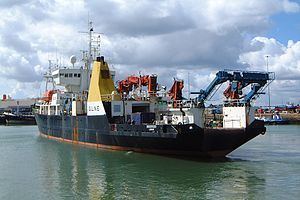Laid down 1962 Construction started 1962 Length 90 m Weight 4,378 tons Builder Hall, Russell & Company | Yard number 899 Out of service 14 December 2012 Launched 21 March 1962 Tonnage 3.008 million kg Displacement 4.378 million kg | |
 | ||
Owner NERC National Marine Facilities Division Identification IMO Number 5090660MMSI Number 233882000Call Sign GLNEICES Code 74E3 | ||
Rrs discovery 1962 top 10 facts
RRS Discovery was a British Royal Research Ship operated by NERC.
RRS Discovery (III) was built in Aberdeen in 1962 and named after Robert Falcon Scott's 1901 ship, RRS Discovery. Until 2006, she was the largest general purpose oceanographic research vessel in use in the United Kingdom. Measuring 90 metres in length, and fitted with a broad range of oceanographic equipment, Discovery could also accommodate containerized laboratories. She had berths for 28 scientific staff, and the ability to spend up to 45 days at sea. Her last major overhaul was in 1991, when a new superstructure and power plant were installed and her hull lengthened by 10 metres.
Discovery carried out oceanographic and marine biology research from the National Oceanography Centre, Southampton. She operated as part of a fleet maintained by the Natural Environment Research Council (NERC) National Marine Facilities Division (NMFD), along with the larger RRS James Cook.
In February 2000, Discovery observed some of the largest waves, up to 29.1 metres, recorded by scientific instruments up to that time.
Discovery (III) has been replaced by another ship, and after extensive enquiry within the scientific community, the replacement vessel was named "Discovery" (IV). The 1962 vessel retained the name until disposal. The new vessel has been designed by Skipsteknisk AS of Norway and built in Spain by C.N.P. Freire, S.A for delivery in 2013 and to be available for scientific research in 2014.
